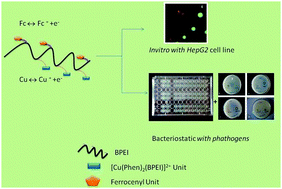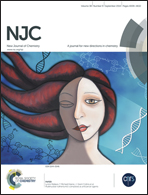Ferrocenyl methylene units and copper(ii) phenanthroline complex units anchored on branched poly(ethyleneimine) – DNA binding, antimicrobial and anticancer activity†
Abstract
Polymer conjugates containing copper(II) phenanthroline complex units and ferrocenyl methylene units bound to the same polymer backbone were synthesized and characterized by spectroscopic and analytical techniques. We could observe both the EPR spectrum for the paramagnetic copper(II) units and the proton NMR spectrum due to the diamagnetic ferrocenyl methylene units. Binding interaction of this complex with calf thymus DNA (CT-DNA) has been investigated by absorption, emission, cyclic voltammetry, and circular dichroism studies. The complex displays significant binding properties to the CT-DNA. In fluorimetric studies, the binding mode of the complex with CT-DNA was investigated using ethidium bromide (EB) as a fluorescence probe. The binding of copper(II) complex units to DNA was facilitated by the presence of ferrocenyl methylene units in the same polymer molecule. These polymer conjugates show good anticancer activity against HepG2 cells and antimicrobial studies have shown better activity.


 Please wait while we load your content...
Please wait while we load your content...